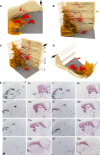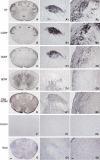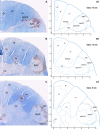The human cuneate nucleus contains discrete subregions whose neurochemical features match those of the relay nuclei for nociceptive information
- PMID: 23975345
- PMCID: PMC4223579
- DOI: 10.1007/s00429-013-0625-4
The human cuneate nucleus contains discrete subregions whose neurochemical features match those of the relay nuclei for nociceptive information
Abstract
The present paper is aimed at defining distinctive subdivisions of the human cuneate nucleus (Cu), evident from prenatal to old life, whose occurrence has never been clearly formalized in the human brain, or described in other species so far. It extends our early observations on the presence of gray matter areas that host strong substance P (SP) immunoreactivity in the territory of the human Cu and adjacent cuneate fascicle. Here we provide a three-dimensional reconstruction of the Cu fields rich in SP and further identify those areas by means of their immunoreactivity to the neuropeptides SP, calcitonin gene-related peptide, methionine- and leucine-enkephalin, peptide histidine-isoleucine, somatostatin and galanin, to the trophins glial cell line-derived neurotrophic factor and brain-derived neurotrophic factor, and to the neuroplasticity proteins polysialylated neural cell adhesion molecule and growth-associated protein-43. The presence, density and distribution of immunoreactivity for each of these molecules closely resemble those occurring in the superficial layers of the caudal spinal trigeminal nucleus (Sp5C). Myelin and Nissl stainings suggest that those Cu subregions and the Sp5C superficial layers share a similar histological aspect. This work establishes the existence of definite subregions, localized within the Cu territory, that bear the neurochemical and histological features of sensory nuclei committed to the neurotransmission of protopathic stimuli, including pain. These findings appear of particular interest when considering that functional, preclinical and clinical studies show that the dorsal column nuclei, classical relay station of fine somatic tactile and proprioceptive sensory stimuli, are also involved in pain neurotransmission.
Figures










Similar articles
-
TRPV1-Like Immunoreactivity in the Human Locus K, a Distinct Subregion of the Cuneate Nucleus.Cells. 2018 Jul 8;7(7):72. doi: 10.3390/cells7070072. Cells. 2018. PMID: 29986526 Free PMC article.
-
GAP-43 in the spinal trigeminal and dorsal column nuclei of the newborn and adult man: immunohistochemical distribution and comparison with that of the neuropeptides SP and CGRP.Ital J Anat Embryol. 1995;100 Suppl 1:205-11. Ital J Anat Embryol. 1995. PMID: 11322293
-
TRPV1 receptor in the human trigeminal ganglion and spinal nucleus: immunohistochemical localization and comparison with the neuropeptides CGRP and SP.J Anat. 2016 Dec;229(6):755-767. doi: 10.1111/joa.12529. Epub 2016 Jul 26. J Anat. 2016. PMID: 27456865 Free PMC article.
-
Somatostatin, galanin and peptide histidine isoleucine in the newborn and adult human trigeminal ganglion and spinal nucleus: immunohistochemistry, neuronal morphometry and colocalization with substance P.J Chem Neuroanat. 1994 Aug;7(3):171-84. doi: 10.1016/0891-0618(94)90027-2. J Chem Neuroanat. 1994. PMID: 7531454
-
[The nucleus tractus solitarius: neuroanatomic, neurochemical and functional aspects].Arch Int Physiol Biochim Biophys. 1991 Sep;99(5):A3-52. doi: 10.3109/13813459109145916. Arch Int Physiol Biochim Biophys. 1991. PMID: 1720691 Review. French.
Cited by
-
TRPV1-Like Immunoreactivity in the Human Locus K, a Distinct Subregion of the Cuneate Nucleus.Cells. 2018 Jul 8;7(7):72. doi: 10.3390/cells7070072. Cells. 2018. PMID: 29986526 Free PMC article.
References
-
- Al-Chaer ED, Feng Y, Willis WD. Comparative study of viscerosomatic input onto postsynaptic dorsal column and spinothalamic tract neurons in the primate. J Neurophysiol. 1999;82:1876–1882. - PubMed
-
- Anand P, Gibson SJ, Yiangou Y, Christofides ND, Polak JM, Bloom SR. PHI-like immunoreactivity co-locates with the VIP-containing system in human lumbosacral spinal cord. Neurosci Lett. 1984;46:191–196. - PubMed
-
- Berkley KJ, Hubscher CH. Are there separate central nervous system pathways for touch and pain? Nat Med. 1995;1:766–773. - PubMed
-
- Bisby MA. Dependence of GAP43 (B50, Fl) transport on axonal regeneration in rat dorsal root ganglion neurons. Brain Res. 1988;458:157–161. - PubMed
MeSH terms
Substances
LinkOut - more resources
Full Text Sources
Other Literature Sources

